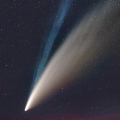
|
Great comet. It approached to Sun down to 0.29 a.u. on July 3, and it brightened up to 0.6 mag (Alan Hale). Now it is fading. But it is still very bright as 6.0 mag (Aug. 8, Marco Goiato). It stays observable in the evening sky until early October when it fades down to 13 mag.
Date(TT) R.A. (2000) Decl. Delta r Elong. m1 Best Time(A, h)
Aug. 8 13 18.64 16 16.3 0.965 0.974 58 6.8 20:30 ( 89, 29)
Aug. 15 13 46.20 8 13.7 1.173 1.115 60 7.9 20:20 ( 80, 27)
|
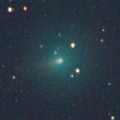
|
Now it is 10.4 mag (Aug. 5, Chris Wyatt). It will brighten up to 8-9 mag from summer to autumn. It will be observable in excellent condition in the Southern Hemisphere. It locates very low in the Northern Hemisphere.
Date(TT) R.A. (2000) Decl. Delta r Elong. m1 Best Time(A, h)
Aug. 8 14 0.52 -13 59.2 1.295 1.459 77 9.8 20:30 ( 56, 19)
Aug. 15 14 17.21 -15 46.7 1.309 1.432 74 9.6 20:20 ( 55, 17)
|

|
Now it is 10.7 mag (Aug. 1, Carlos Labordena). It stays observable in the evening sky until September when it fades down to 12 mag.
Date(TT) R.A. (2000) Decl. Delta r Elong. m1 Best Time(A, h)
Aug. 8 13 37.70 15 25.0 2.286 2.047 63 10.2 20:30 ( 86, 33)
Aug. 15 13 48.15 11 35.1 2.404 2.102 60 10.4 20:20 ( 83, 29)
|
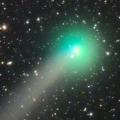
|
It brightened up to 6.0 mag in June (June 13, Marco Goiato). Now it is fading. It has already faded down to 10.2 mag (Aug. 5, Chris Wyatt). It stays observable in good condition for a long time after this.
Date(TT) R.A. (2000) Decl. Delta r Elong. m1 Best Time(A, h)
Aug. 8 13 53.74 19 13.7 1.257 1.264 66 10.3 20:30 ( 88, 38)
Aug. 15 14 18.73 20 37.3 1.374 1.345 66 11.0 20:20 ( 88, 41)
|
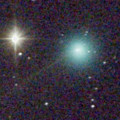
|
Now it is 10.5 mag (Aug. 5, Chris Wyatt). In the Southern Hemisphere, it stays observable in good condition in the evening sky while the comet will be fading. It locates very low in the Northern Hemisphere.
Date(TT) R.A. (2000) Decl. Delta r Elong. m1 Best Time(A, h)
Aug. 8 13 12.53 -24 3.9 0.659 1.014 71 11.5 20:30 ( 56, 4)
Aug. 15 14 12.50 -28 24.2 0.734 1.127 78 12.4 20:20 ( 47, 8)
|
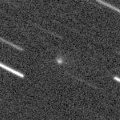
|
Now it is 15.5 mag (July 22, Martin Masek). Small comet. But it will approach to Sun down to 0.47 a.u. in September, and it is expected to brighten up to 11 mag. It stays observable in good condition until late August while the comet will be brightening up to 11 mag.
Date(TT) R.A. (2000) Decl. Delta r Elong. m1 Best Time(A, h)
Aug. 8 4 14.08 30 55.0 0.622 0.979 68 12.9 3:39 (260, 47)
Aug. 15 5 37.45 26 3.4 0.598 0.855 57 12.2 3:47 (261, 36)
|
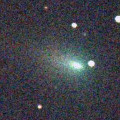
|
Recovered from SWAN images after 24-year blank. It brightened up to 10.2 mag in spring (May 31, Marco Goiato). Now it is fading. But it is still bright as 12.5 mag (July 27, Paul Camilleri). It stays observable for a long time after this until the comet fades out.
Date(TT) R.A. (2000) Decl. Delta r Elong. m1 Best Time(A, h)
Aug. 8 5 25.59 13 2.1 1.973 1.617 54 13.0 3:39 (270, 24)
Aug. 15 5 42.44 12 43.2 1.969 1.659 57 13.3 3:47 (273, 27)
|
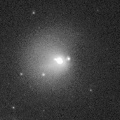
|
Outburst occured on July 27. Now it is bright as 13.1 mag (July 31, Martin Masek).
Date(TT) R.A. (2000) Decl. Delta r Elong. m1 Best Time(A, h)
Aug. 8 2 49.67 26 9.5 5.766 5.817 87 13.5 3:39 (280, 62)
Aug. 15 2 51.42 26 28.7 5.659 5.818 94 13.5 3:47 (287, 69)
|

|
Now it is 13.5 mag (July 31, Ken-ichi Kadota). It is expected to brighten up to 12 mag from autumn to winter. In the Northern Hemisphere, it stays observable in good condition while the comet will be brightening gradually, but it is hardly observable at the high light. In the Southern Hemisphere, it is not observable for a long time, but it will be observable in good condition after the high light.
Date(TT) R.A. (2000) Decl. Delta r Elong. m1 Best Time(A, h)
Aug. 8 12 13.68 36 21.5 2.863 2.260 44 13.8 20:30 (117, 26)
Aug. 15 12 18.71 32 45.9 2.869 2.205 40 13.7 20:20 (115, 22)
|
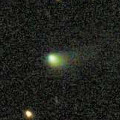
|
Now it is 14.2 mag (July 16, Paul Camilleri). It stays 13-14 mag from 2020 to 2021. It will be unobservable in September.
Date(TT) R.A. (2000) Decl. Delta r Elong. m1 Best Time(A, h)
Aug. 8 13 12.29 3 37.5 3.429 3.054 60 14.3 20:30 ( 79, 21)
Aug. 15 13 19.75 2 20.3 3.494 3.042 55 14.4 20:20 ( 79, 18)
|

|
Now it is 13.9 mag (July 19, Ken-ichi Kadota). It stays 14 mag until autumn. In the Southern Hemisphere, it will never be observable again.
Date(TT) R.A. (2000) Decl. Delta r Elong. m1 Best Time(A, h)
Aug. 8 11 39.53 82 40.3 4.316 4.047 68 14.4 20:30 (171, 35)
Aug. 15 12 23.41 80 47.1 4.338 4.088 69 14.4 20:20 (168, 36)
|
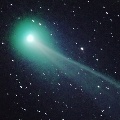
|
It brightened up to 4.7 mag in early May (May 2, Marco Goiato). However, it has faded and got diffused after that. It had already faded down to 7.3 mag in late May (May 21, Mitsunori Tsumura). It is appearing in the morning sky. However, maybe it has already disappeared. It stays observable in good condition after this.
Date(TT) R.A. (2000) Decl. Delta r Elong. m1 Best Time(A, h)
Aug. 8 6 42.21 19 29.7 2.300 1.592 35 14.5 3:39 (254, 12)
Aug. 15 6 44.61 17 36.5 2.319 1.706 41 14.8 3:47 (260, 17)
|

|
It was expected to brighten very rapidly, and brighten up to 14.5 mag from August to September. However, its current brightness is very uncertain. It could not be detected as fainter than 18.0 mag on June 30 (Charles S. Morris), and fainter than 15.7 mag on July 13 (Sandor Szabo). However, Giuseppe Pappa reported as 14 mag on July 10, and Thomas Lehmann reported it is bright as 15.2 mag on July 12. In the Northern Hemisphere, it stays observable for a long time, although it becomes extremely low in early September. In the Southern Hemisphere, it is not observable until late October.
Date(TT) R.A. (2000) Decl. Delta r Elong. m1 Best Time(A, h)
Aug. 8 10 28.23 61 31.5 1.368 1.010 47 14.7 20:30 (150, 22)
Aug. 15 10 34.71 54 34.8 1.450 0.972 41 14.7 20:20 (145, 17)
|
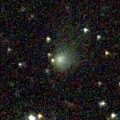
|
Now it is 15.0 mag (July 12, Sandor Szabo). It is expected to be observable at 5-6 mag for a long time from 2022 to 2023. In the Northern Hemisphere, it is not observable at the high light from 2022 summer to 2023 summer. In the Southern Hemisphere, it is only visible in the extremely low sky in summer in 2020. But it will be observable in good condition at the high light.
Date(TT) R.A. (2000) Decl. Delta r Elong. m1 Best Time(A, h)
Aug. 8 17 10.65 49 43.1 8.390 8.545 95 14.9 20:30 (162, 74)
Aug. 15 17 8.20 48 53.5 8.373 8.493 93 14.9 20:20 (150, 73)
|
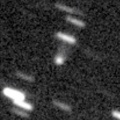
|
Now it is 15.4 mag (July 9, R. Carstens). It will brighten up to 13 mag in 2021. In the Northern Hemisphere, it will be unobservable soon. In the Southern Hemisphere, it stays observable at 15 mag until October.
Date(TT) R.A. (2000) Decl. Delta r Elong. m1 Best Time(A, h)
Aug. 8 13 53.53 -25 15.4 4.643 4.577 79 14.9 20:30 ( 50, 9)
Aug. 15 13 55.90 -25 53.3 4.711 4.540 74 14.9 20:20 ( 52, 7)
|
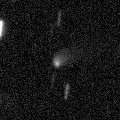
|
Now it is 15.1 mag (July 18, P. Camilleri, H. Williams, J. Oey, M. Al-Bussadi). It stays 14-15 mag until 2021. In the Southern Hemisphere, it stays observable in good condition for a long time. In the Northern Hemisphere, it is not observable until June in 2021.
Date(TT) R.A. (2000) Decl. Delta r Elong. m1 Best Time(A, h)
Aug. 8 15 6.29 -78 54.6 4.341 4.715 105 15.2 20:30 ( 7,-26)
Aug. 15 15 20.62 -78 4.9 4.363 4.693 102 15.2 20:20 ( 8,-25)
|

|
Now it is 15.2 mag (July 3, R. Carstens). It will brighten up to 13.5 mag in spring in 2021. In the Southern Hemisphere, it stays observable in good condition for a long time. In the Northern Hemisphere, it is not observable until spring in 2021.
Date(TT) R.A. (2000) Decl. Delta r Elong. m1 Best Time(A, h)
Aug. 8 19 11.16 -65 53.4 3.406 4.089 126 15.3 22:00 ( 0,-11)
Aug. 15 18 43.23 -64 56.1 3.437 4.054 121 15.3 21:05 ( 0,-10)
|
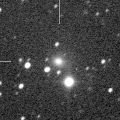
|
It brightened up to 13.5 mag in winter (Dec. 6, Chris Wyatt). Now it is fading slowly. Now it is 15.1 mag (July 25, ATLAS-MLO, Mauna Loa). In the Southern Hemisphere, it stays observable for a long time. In the Northern Hemisphere, it is appearing in the morning sky, but it stays low for a while.
Date(TT) R.A. (2000) Decl. Delta r Elong. m1 Best Time(A, h)
Aug. 8 3 23.74 -35 37.8 3.868 4.118 97 15.4 3:39 (328, 10)
Aug. 15 3 21.59 -36 1.1 3.827 4.152 101 15.4 3:47 (335, 14)
|
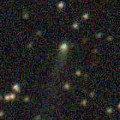
|
Now it is 15.6 mag (July 19, Thomas Lehmann). It stays 15-16 mag for a long time until 2021.
Date(TT) R.A. (2000) Decl. Delta r Elong. m1 Best Time(A, h)
Aug. 8 19 10.49 19 55.6 3.741 4.495 133 15.4 22:00 ( 0, 75)
Aug. 15 19 1.71 20 8.9 3.801 4.501 128 15.4 21:24 ( 0, 75)
|
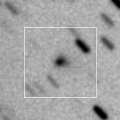
|
Now it is 14.7 mag (July 27, D. Buczynski). It will brighten up to 12 mag in winter in 2022. In the Northern Hemisphere, it stays observable in good condition for a long time. In the Southern Hemisphere, it is not observable until 2021 November.
Date(TT) R.A. (2000) Decl. Delta r Elong. m1 Best Time(A, h)
Aug. 8 0 56.29 61 15.1 5.632 5.737 90 15.5 3:39 (183, 64)
Aug. 15 0 56.02 62 9.8 5.521 5.693 94 15.5 3:22 (180, 63)
|
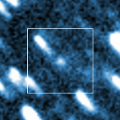
|
Now it is 15.2 mag (July 12, Sandor Szabo). It is observable at 15-16 mag in good condition from June to August.
Date(TT) R.A. (2000) Decl. Delta r Elong. m1 Best Time(A, h)
Aug. 8 19 8.79 -4 44.8 1.129 2.058 147 15.5 21:59 ( 0, 50)
Aug. 15 19 9.22 -5 54.3 1.165 2.062 142 15.5 21:32 ( 0, 49)
|
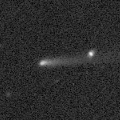
|
Now it is 15.7 mag (July 28, Martin Masek). It was expected to brighten rapidly up to 9.5 mag in June. But actually, it is fainter than predicted. However, it became very bright as 7.5 mag in SOHO spacecraft images on June 19 (Karl Battams). It is observable in good condition after this while the comet will be fading.
Date(TT) R.A. (2000) Decl. Delta r Elong. m1 Best Time(A, h)
Aug. 8 5 56.43 25 43.9 1.278 0.936 46 15.6 3:39 (254, 24)
Aug. 15 6 10.48 25 7.3 1.343 1.040 49 16.4 3:47 (258, 28)
|

|
Now it is 15.4 mag (July 29, Martin Masek). It stays 15.5 mag from summer to winter, and observable in good condition. It locates somewhat low in the Southern Hemisphere.
Date(TT) R.A. (2000) Decl. Delta r Elong. m1 Best Time(A, h)
Aug. 8 5 51.77 19 18.0 2.344 1.823 47 15.7 3:39 (261, 22)
Aug. 15 6 8.80 19 27.3 2.318 1.845 50 15.6 3:47 (263, 26)
|

|
Now it is 15.6 mag (July 25, ATLAS-MLO, Mauna Loa). It is observable at 15-16 mag in 2020. It is observable in excellent condition in the Southern Hemisphere. It locates somewhat low in the Northern Hemisphere.
Date(TT) R.A. (2000) Decl. Delta r Elong. m1 Best Time(A, h)
Aug. 8 18 27.11 -27 50.0 5.987 6.796 140 15.8 21:18 ( 0, 27)
Aug. 15 18 21.31 -27 27.6 6.090 6.812 132 15.8 20:44 ( 0, 28)
|
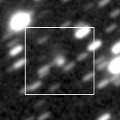
|
Now it is 16.1 mag (Aug. 1, M. Jaeger, E. Prosperi, S. Prosperi, W. Vollmann). It will stay at 15 mag for a long time from 2021 to 2022. In the Northern Hemisphere, it stays observable in good condition while brightening gradually. In the Southern Hemisphere, it stays locating low for a long time.
Date(TT) R.A. (2000) Decl. Delta r Elong. m1 Best Time(A, h)
Aug. 8 17 44.57 27 38.3 5.578 6.051 113 16.1 20:35 ( 0, 83)
Aug. 15 17 40.12 26 19.3 5.611 6.023 109 16.0 20:20 ( 24, 80)
|

|
New comet. Although it is a tiny comet, it will approach to Sun down to 0.34 a.u. on Oct. 20, and it is expected to brighten up to 8.5 mag. In the Southern Hemisphere, it stays observable in good condition until late September when it brightens up to 11.5 mag. In the Northern Hemisphere, it stays unobservable for a while. But it will appear in the morning sky at 10 mag in late October. Then it stasy observable while the comet will be fading rapidly.
Date(TT) R.A. (2000) Decl. Delta r Elong. m1 Best Time(A, h)
Aug. 8 12 36.59 -73 46.9 1.206 1.650 95 16.6 20:30 ( 18,-30)
Aug. 15 12 28.04 -70 11.9 1.162 1.531 89 16.2 20:20 ( 23,-30)
|

|
Now it is 16.8 mag (July 2, R. Carstens). It brightens up to 16 mag from summer to winter. In the Southern Hemisphere, it is observable in excellent condition. In the Northern Hemisphere, it is not observable until late October.
Date(TT) R.A. (2000) Decl. Delta r Elong. m1 Best Time(A, h)
Aug. 8 22 6.39 -70 0.7 1.060 1.844 125 16.4 1:02 ( 0,-15)
Aug. 15 21 49.94 -70 40.0 1.027 1.796 123 16.3 0:18 ( 0,-16)
|
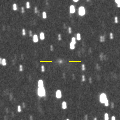
|
Now it is 16.5 mag (July 19, Thomas Lehmann). It will brighten up to 16.5 mag and will be observable in good condition from June to October.
Date(TT) R.A. (2000) Decl. Delta r Elong. m1 Best Time(A, h)
Aug. 8 20 18.53 16 38.5 1.250 2.158 144 16.3 23:09 ( 0, 72)
Aug. 15 20 15.49 15 45.4 1.250 2.152 143 16.3 22:38 ( 0, 71)
|
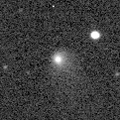
|
It brightened up to 13.8 mag in autumn in 2019 (Sept. 3, Chris Wyatt). Now it is fading slowly. Now it is 16.1 mag (July 28, Martin Masek). In 2020, it stays observable in good condition while the comet will be fading from 16 to 17 mag.
Date(TT) R.A. (2000) Decl. Delta r Elong. m1 Best Time(A, h)
Aug. 8 0 34.30 1 1.3 5.367 6.035 127 16.4 3:28 ( 0, 56)
Aug. 15 0 31.55 1 13.1 5.322 6.076 134 16.4 2:58 ( 0, 56)
|
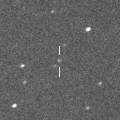
|
Now it is 16.4 mag (July 25, G. Hug). It will brighten up to 14.5 mag from spring to summer in 2021. In the Southern Hemisphere, it stays observable in excellent condition for a long time. In the Northern Hemisphere, it is observable in good condition in 2020, however, it will be unobservable in 2021.
Date(TT) R.A. (2000) Decl. Delta r Elong. m1 Best Time(A, h)
Aug. 8 22 55.99 0 57.8 2.821 3.728 149 16.5 1:50 ( 0, 56)
Aug. 15 22 47.99 -1 15.4 2.719 3.681 158 16.4 1:15 ( 0, 54)
|

|
Now it is 17.0 mag (July 29, ATLAS-MLO, Mauna Loa). It will brighten up to 14 mag in November, and will be observable in excellent condition.
Date(TT) R.A. (2000) Decl. Delta r Elong. m1 Best Time(A, h)
Aug. 8 1 50.94 -35 5.1 0.998 1.704 115 16.8 3:39 (346, 18)
Aug. 15 2 10.56 -35 40.6 0.921 1.641 115 16.5 3:47 (350, 19)
|
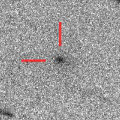
|
Now it is 16.4 mag (Aug. 2, ATLAS-HKO, Haleakala). It brightens up to 16 mag in September. It is observable in good condition in the Northern Hemisphere. It locates low in the Southern Hemisphere.
Date(TT) R.A. (2000) Decl. Delta r Elong. m1 Best Time(A, h)
Aug. 8 4 55.02 21 27.6 1.393 1.260 60 16.7 3:39 (267, 35)
Aug. 15 5 22.17 22 14.7 1.383 1.259 61 16.5 3:47 (267, 37)
|

|
Now it is 17.9 mag (July 31, ATLAS-HKO, Haleakala). It is expected to brighten up to 15 mag from October to November, and it will be observable in excellent condition.
Date(TT) R.A. (2000) Decl. Delta r Elong. m1 Best Time(A, h)
Aug. 8 0 11.24 -35 32.8 0.877 1.752 135 16.7 3:05 ( 0, 20)
Aug. 15 0 14.66 -36 22.3 0.809 1.706 138 16.5 2:41 ( 0, 19)
|
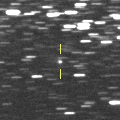
|
Now it is 16.8 mag (July 20, A. Diepvens). It will be observable at 16.5-17 mag from spring in 2020 to summer in 2021.
Date(TT) R.A. (2000) Decl. Delta r Elong. m1 Best Time(A, h)
Aug. 8 17 46.95 15 30.6 4.093 4.686 120 16.6 20:37 ( 0, 70)
Aug. 15 17 39.77 13 55.6 4.165 4.678 114 16.6 20:20 ( 12, 68)
|
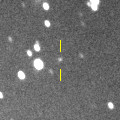
|
Now it is 15.9 mag (Apr. 24, J. Drummond). It is expected to brighten up to 13 mag in 2022. In 2020, it is observable in excellent condition in the Southern Hemisphere. In the Northern Hemisphere, it is not observable. It will be observable from autumn to winter, but it locating extremely low.
Date(TT) R.A. (2000) Decl. Delta r Elong. m1 Best Time(A, h)
Aug. 8 7 36.20 -26 24.9 7.422 6.794 48 16.7 3:39 (286,-24)
Aug. 15 7 41.71 -26 48.6 7.363 6.754 49 16.6 3:47 (290,-19)
|

|
It brightened up to 13.2 mag from spring to autumn in 2019 (June 30, Thomas Lehmann). Now it is fading slowly. It has already faded down to 16.6 mag (July 17, ATLAS-MLO, Mauna Loa). In the Southern Hemisphere, it stays observable for a long time. In the Northern Hemisphere, it stays low for a long time.
Date(TT) R.A. (2000) Decl. Delta r Elong. m1 Best Time(A, h)
Aug. 8 23 36.23 -31 1.0 3.605 4.466 144 16.7 2:30 ( 0, 24)
Aug. 15 23 27.98 -31 3.5 3.602 4.506 149 16.8 1:55 ( 0, 24)
|
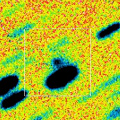
|
Now it is 16.4 mag (July 29, ATLAS-MLO, Mauna Loa). It brightens up to 15 mag in winter. But it is not observable at high light. In the Southern Hemisphere, it stays observable in good condition until autumn when the comet will brighten up to 16 mag. It stays locating very low in the Northern Hemisphere.
Date(TT) R.A. (2000) Decl. Delta r Elong. m1 Best Time(A, h)
Aug. 8 17 52.62 -41 49.5 1.765 2.541 130 16.9 20:44 ( 0, 13)
Aug. 15 17 51.65 -40 34.5 1.801 2.514 124 16.8 20:20 ( 1, 14)
|
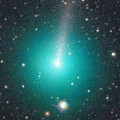
|
It brightened up to 8 mag from March to April. It continued brightening for a while even after the perihelion passage on Mar. 15. But it is fading now. It is still visible visually as 13.0 mag (July 12, Sandor Szabo). However, it has already faded down to 17.0 mag by CCD (July 2, Charles S. Morris). It seems to be a fragment of C/1988 A1 (Liller), like C/1996 Q1 (Tabur) and C/2015 F3 (SWAN).
Date(TT) R.A. (2000) Decl. Delta r Elong. m1 Best Time(A, h)
Aug. 8 12 46.34 6 53.3 2.941 2.469 53 16.8 20:30 ( 86, 18)
Aug. 15 12 53.00 4 43.8 3.109 2.556 48 17.2 20:20 ( 86, 14)
|
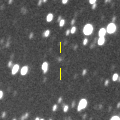
|
Now it is 16.2 mag (July 22, D. Buczynski). It will be observable at 16.5-17 mag from 2020 to 2021. In the Southern Hemisphere, it is not observable until summer in 2021.
Date(TT) R.A. (2000) Decl. Delta r Elong. m1 Best Time(A, h)
Aug. 8 1 29.75 73 47.6 6.192 6.121 81 16.9 3:39 (185, 51)
Aug. 15 1 15.60 74 16.3 6.107 6.110 85 16.9 3:43 (180, 51)
|
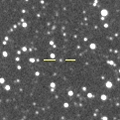
|
Now it is 16.6 mag (July 21, R. Haver, R. Gorelli, M. Calabresi, M. Panella). It stays at 17 mag from 2020 to 2021.
Date(TT) R.A. (2000) Decl. Delta r Elong. m1 Best Time(A, h)
Aug. 8 19 15.08 32 13.8 8.297 8.905 124 17.1 22:05 ( 0, 87)
Aug. 15 19 11.36 32 12.0 8.323 8.899 121 17.1 21:34 ( 0, 87)
|

|
First return of a new periodic comet which brightened up to 17.5 mag in 2012. Now it is 17.3 mag (July 23, ATLAS-MLO, Mauna Loa). It stays observable at 17 mag in good condition from summer to winter. It locates somewhat low in the Southern Hemisphere.
Date(TT) R.A. (2000) Decl. Delta r Elong. m1 Best Time(A, h)
Aug. 8 4 2.45 26 11.4 2.408 2.305 71 17.3 3:39 (268, 47)
Aug. 15 4 13.92 27 13.9 2.340 2.314 75 17.3 3:47 (270, 53)
|
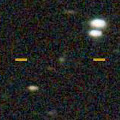
|
Now it is 17.1 mag (July 31, ATLAS-HKO, Haleakala). It became brighter than orignally predicted. It stays observable at 17 mag in good condition until autumn.
Date(TT) R.A. (2000) Decl. Delta r Elong. m1 Best Time(A, h)
Aug. 8 13 51.44 -16 27.1 2.104 2.105 76 17.3 20:30 ( 56, 15)
Aug. 15 14 3.70 -17 36.4 2.166 2.099 72 17.3 20:20 ( 56, 14)
|

|
It brightened up to 7.7 mag in June in 2018 (June 19, Juan Jose Gonzalez). Now it is fading. It has already faded down to 16.9 mag (Apr. 22, J. Drummond). In the Southern Hemisphere, it stays observable for a long time until the comet will fade out. It will be observable in good condition after late August also in the Northern Hemisphere.
Date(TT) R.A. (2000) Decl. Delta r Elong. m1 Best Time(A, h)
Aug. 8 6 30.10 -10 10.7 7.967 7.327 48 17.4 3:39 (281, -3)
Aug. 15 6 32.50 -10 17.8 7.957 7.380 52 17.4 3:47 (285, 4)
|
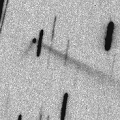
|
Main-belt asteroid. But it showed a straight tail like a comet in 2019. In 2020, it brightens up to 16.5 mag and stays observable in good condition from September to October.
Date(TT) R.A. (2000) Decl. Delta r Elong. m1 Best Time(A, h)
Aug. 8 0 40.90 12 57.4 1.465 2.167 120 17.6 3:34 ( 0, 68)
Aug. 15 0 41.64 12 2.1 1.411 2.183 127 17.5 3:08 ( 0, 67)
|

|
Now it is 18.8 mag (July 18, Jost Jahn). It will brighten up to 17.5 mag in autumn. It is observable in excellent condition in the Southern Hemisphere. It locates very low in the Northern Hemisphere.
Date(TT) R.A. (2000) Decl. Delta r Elong. m1 Best Time(A, h)
Aug. 8 23 31.86 -26 13.1 2.258 3.150 146 17.6 2:26 ( 0, 29)
Aug. 15 23 30.18 -27 51.2 2.225 3.147 150 17.6 1:57 ( 0, 27)
|

|
Now it is 19.3 mag (July 27, Jost Jahn). It will brighten up to 17.5 mag in September. It is observable in excellent condition in the Southern Hemisphere. It locates somewhat low in the Northern Hemisphere.
Date(TT) R.A. (2000) Decl. Delta r Elong. m1 Best Time(A, h)
Aug. 8 23 19.19 -9 32.6 1.085 2.020 148 17.7 2:13 ( 0, 46)
Aug. 15 23 20.20 -11 36.9 1.045 2.010 155 17.6 1:46 ( 0, 44)
|

|
Now it is 16.8 mag (July 18, P. Camilleri, H. Williams, J. Oey, M. Al-Bussadi). It will brighten up to 15.5 mag in early 2021. In 2020, it stays observable at 17 mag until November in the Southern Hemisphere. In the Northern Hemisphere, it will be unobservable soon. Then it stays unobservable until 2021 June.
Date(TT) R.A. (2000) Decl. Delta r Elong. m1 Best Time(A, h)
Aug. 8 14 12.54 -28 37.6 2.748 2.848 85 17.7 20:30 ( 44, 10)
Aug. 15 14 18.76 -28 42.2 2.785 2.793 79 17.7 20:20 ( 46, 8)
|
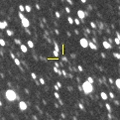
|
Sam Deen pointed out that it brightened in outburst twice in 2017 and 2019. It was observed at 20-21 mag in 2017. Then it became fainter than 22.9 mag in 2018 summer (Aug. 29, Sam Deen). However, it brightened up to 17.2 mag in 2019 spring (Mar. 25, B. T. Bolin). Then it faded again down to 19.9 mag (May 29, Toshihiko Ikemura, Hirohisa Sato). Now it is 18.1 mag (July 9, J. Jahn). It is predicted to stay observable at 18 mag for a long time from 2019 to 2021. But actually, it may be fainter than this ephemeris.
Date(TT) R.A. (2000) Decl. Delta r Elong. m1 Best Time(A, h)
Aug. 8 18 34.48 -24 3.8 6.899 7.726 142 17.7 21:25 ( 0, 31)
Aug. 15 18 31.72 -24 35.3 6.983 7.731 134 17.7 20:55 ( 0, 30)
|
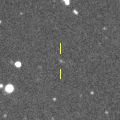
|
Now it is 17.3 mag (July 31, ATLAS-HKO, Haleakala). It stays 18 mag from 2019 to 2020.
Date(TT) R.A. (2000) Decl. Delta r Elong. m1 Best Time(A, h)
Aug. 8 21 4.85 -6 2.5 3.590 4.592 169 17.7 23:55 ( 0, 49)
Aug. 15 21 1.38 -6 28.0 3.598 4.593 168 17.7 23:24 ( 0, 49)
|

|
Now it is 17.4 mag (July 26, J. Drummond). It will brighten up to 16.5 mag in 2021 summer. In the Southern Hemisphere, it stays observable for a while. In the Northern Hemisphere, it is not observable until 2021 February.
Date(TT) R.A. (2000) Decl. Delta r Elong. m1 Best Time(A, h)
Aug. 8 14 27.74 -50 43.8 5.518 5.707 95 17.8 20:30 ( 28, -5)
Aug. 15 14 31.94 -49 37.7 5.585 5.680 90 17.8 20:20 ( 30, -6)
|
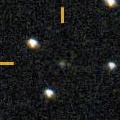
|
It is observable at 17-18 mag for a long time from late 2019 to early 2021. It will fade out before it passes the perihelion.
Date(TT) R.A. (2000) Decl. Delta r Elong. m1 Best Time(A, h)
Aug. 8 5 26.53 15 56.1 5.208 4.686 54 17.8 3:39 (268, 25)
Aug. 15 5 32.19 16 2.9 5.109 4.674 59 17.8 3:47 (272, 31)
|

|
Now it is 18.4 mag (July 20, A. Diepvens). It will be fading slowly after this. It is observable in good condition in the Northern Hemisphere. In the Southern Hemisphere, it is observable in the extremely low sky only in 2021 spring.
Date(TT) R.A. (2000) Decl. Delta r Elong. m1 Best Time(A, h)
Aug. 8 12 49.05 43 23.3 9.570 8.999 53 17.8 20:30 (122, 35)
Aug. 15 12 52.01 42 33.8 9.627 9.013 50 17.8 20:20 (122, 32)
|

|
Now it is 17.3 mag (July 18, Katsumi Yoshimoto). It will fade out rapidly after this. It locates extremely low in the Northern Hemisphere.
Date(TT) R.A. (2000) Decl. Delta r Elong. m1 Best Time(A, h)
Aug. 8 17 52.18 -44 53.3 0.985 1.807 129 17.8 20:39 ( 0, 10)
Aug. 15 17 2.25 -39 45.4 1.121 1.799 114 18.1 20:20 ( 11, 14)
|
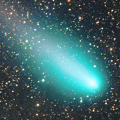
|
Fragment of C/1844 Y1 (Great Comet). It brightened up to 7.0 mag in late March ((Mar. 30, Charles S. Morris). But the nucleus was split into some fragments, and it faded out after that. In the Northern Hemisphere, it is not observable after this. In the Southern Hemisphere, it is appearing in the morning sky, but it locates extremely low.
Date(TT) R.A. (2000) Decl. Delta r Elong. m1 Best Time(A, h)
Aug. 8 6 52.81 0 32.2 2.309 1.631 37 20.4 3:39 (269, -1)
Aug. 15 7 1.56 -0 3.2 2.378 1.751 41 20.8 3:47 (273, 4)
|
|
![]()
 C/2017 K2 ( PanSTARRS )
C/2017 K2 ( PanSTARRS ) C/2019 F1 ( ATLAS-Africano )
C/2019 F1 ( ATLAS-Africano ) C/2020 F5 ( MASTER )
C/2020 F5 ( MASTER ) C/2020 J1 ( SONEAR )
C/2020 J1 ( SONEAR ) C/2018 F4 ( PanSTARRS )
C/2018 F4 ( PanSTARRS ) C/2019 K7 ( Smith )
C/2019 K7 ( Smith ) C/2019 L3 ( ATLAS )
C/2019 L3 ( ATLAS ) 115P/Maury
115P/Maury 249P/LINEAR
249P/LINEAR 84P/Giclas
84P/Giclas C/2017 U7 ( PanSTARRS )
C/2017 U7 ( PanSTARRS ) C/2018 U1 ( Lemmon )
C/2018 U1 ( Lemmon ) C/2020 P1 ( NEOWISE )
C/2020 P1 ( NEOWISE ) 162P/Siding Spring
162P/Siding Spring 257P/Catalina
257P/Catalina C/2017 B3 ( LINEAR )
C/2017 B3 ( LINEAR ) C/2019 T2 ( Lemmon )
C/2019 T2 ( Lemmon ) C/2020 M3 ( ATLAS )
C/2020 M3 ( ATLAS ) 304P/Ory
304P/Ory 156P/Russell-LINEAR
156P/Russell-LINEAR C/2017 Y2 ( PanSTARRS )
C/2017 Y2 ( PanSTARRS ) C/2019 T4 ( ATLAS )
C/2019 T4 ( ATLAS ) C/2018 A6 ( Gibbs )
C/2018 A6 ( Gibbs ) 17P/Holmes
17P/Holmes C/2019 Y1 ( ATLAS )
C/2019 Y1 ( ATLAS ) C/2019 T3 ( ATLAS )
C/2019 T3 ( ATLAS ) C/2019 O3 ( Palomar )
C/2019 O3 ( Palomar ) P/2020 M2 ( Lemmon )
P/2020 M2 ( Lemmon ) 278P/McNaught
278P/McNaught C/2016 M1 ( PanSTARRS )
C/2016 M1 ( PanSTARRS ) (6478) Gault
(6478) Gault 254P/McNaught
254P/McNaught 312P/NEAT
312P/NEAT 28P/Neujmin 1
28P/Neujmin 1 C/2017 K5 ( PanSTARRS )
C/2017 K5 ( PanSTARRS ) P/2019 LD2 ( ATLAS )
P/2019 LD2 ( ATLAS ) C/2020 O2 ( Amaral )
C/2020 O2 ( Amaral ) 173P/Mueller 5
173P/Mueller 5 C/2010 U3 ( Boattini )
C/2010 U3 ( Boattini ) C/2020 N2 ( ATLAS )
C/2020 N2 ( ATLAS ) C/2019 Y4 ( ATLAS )
C/2019 Y4 ( ATLAS )![]()








































